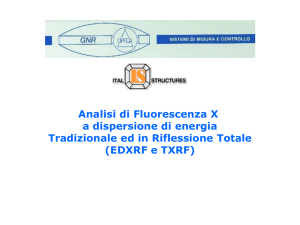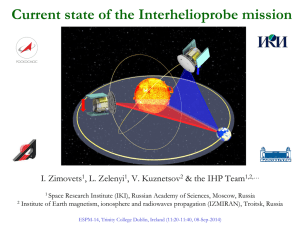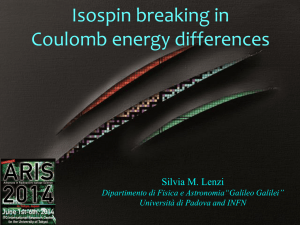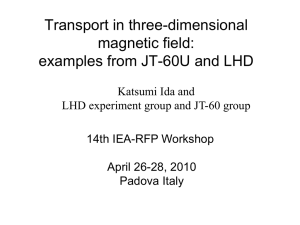212 Pb
advertisement
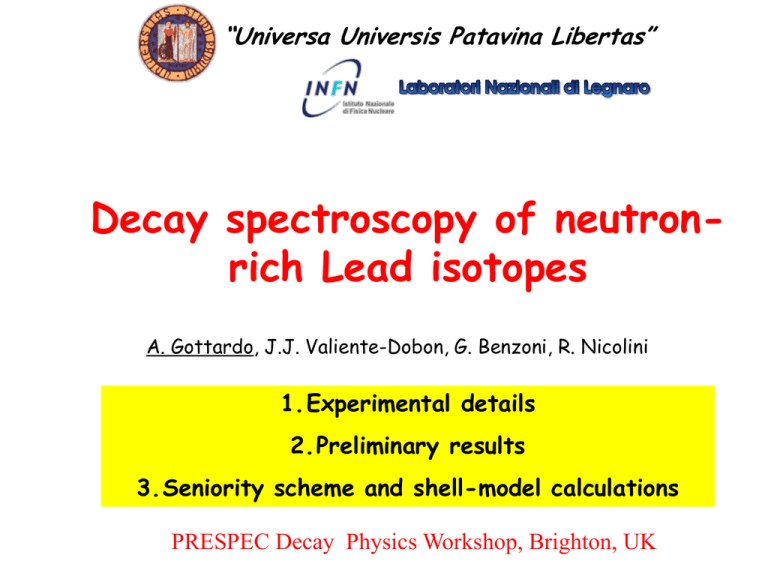
“Universa Universis Patavina Libertas” Decay spectroscopy of neutronrich Lead isotopes A. Gottardo, J.J. Valiente-Dobon, G. Benzoni, R. Nicolini 1.Experimental details 2.Preliminary results 3.Seniority scheme and shell-model calculations PRESPEC Decay Physics Workshop, Brighton, UK The physical motivations Need to test stability of shell structure in this region (N=126, Z=82): weakening of Z=82 when approaching drip-line ? Presence of isomers involving high-j orbitals νg9/2, νi11/2, νj15/2.Taking advantage of these isomers we want to study the developmet of nuclear structure from 212Pb up to 220Pb and nearby nuclei Beta-decay half-lives for the r-process I.N. Borzov PRC67, 025802 (2003) •Experimental β-decay data needed around 208Pb to validate theoretical models. •β-lifetimes needed r-process calculations. •Last lifetime measured for 215Pb The experimental challanges GSI • 5x106 pps • 2 HPGe detectors (Effγ=1%) • 350 ions implanted M. Pfutzner, PLB 444 (1998) 32 Difficult region to explore: only fragmentation possible, primary beam charge states! The experimental setup FRS-Rising at GSI: stopped beam campaign 9 DSSSD, 1mm thick, 5x5 cm2 15 CLUSTERs x 7 crystals 16x16 x-y strips ε = 11% at 1.3MeV γ Beam: 238U @ 1GevA S1 Target 2.5 g/cm2 Be S2 Deg. S1: Al 2.0 g/cm2 S3 S4 MONOCHROMATIC Deg S2: Al 758 mg/cm2 Picture courtesy of P. Boutachkov, GSI Charged-states selection Formation of many charge states owing to interactions with materials Isotope identification is more complicated Need to disentangle nuclei that change their charge state after S2 deg. (Br)Ta-S2 – (Br)S2-S4 215Pb_sett DQ=-1 DQ=0 217Pb_sett Z DQ=-2 DQ=+1 Br1 - Br2 Br1 - Br2 The exotic nuclei production 1 GeVA 238U beam from UNILAC-SIS at 109 pps Z 215 212Pb Bi 209Tl 206Hg Z minA MaxA 80 206 210 81 209 213 82 212 218 83 215 220 219Bi 218Pb 213Tl 210Hg A/q 212,214,216Pb: 8+ isomer 216Pb 6+ -> 4+: 160 keV : + 8 isomer T1/2 = 0.40 (1) μs 4+ -> 2+: 401 keV 2+ -> 0+: 887 keV 197 keV 490 keV 214Pb 217Bi πh 9/2 Energy (keV) 216 T1/2 = 2.31 (6) μs 742 keV Pb 214Pb 210Hg isomer 208Hg PRC 80, 061302(R) Change in structure ? 210Hg Energy (keV) The seniority scheme Nucleons in a valence jn configuration behave according to a seniority scheme: the states can be labelled by their seniority ν SENIORITY SCHEME ν=2 8+ 6+ 4+ 2+ 8+ 6+ 4+ 2+ 8+ 6+ 4+ 2+ 8+ 6+ 4+ 2+ ν=0 0+ 0+ 0+ 0+ (2g9/2)2 (2g9/2)4 (2g9/2)6 (2g9/2)8 For even-even nuclei, the 0+ ground state has seniority ν = 0, while the 2+, 4+, 6+, 8+ states have ν = 2 In a pure seniority scheme, the relative level energies do not depend on the number of particles in the shell j The experimental levels and the seniority scheme The 8+ isomer is a seniority isomer, involving neutrons in the 2g9/2 210Pb 212Pb 216Pb 214Pb 8+ X 8+ X The valence space in the Kuo-Herling interaction 208Pb is a doubly-magic nucleus (Z=82, N=126). For neutron-rich Lead isotopes, the N=6 major shell is involved S.p. energies (MeV) -1.40 -1.45 -1.90 -2.37 -2.51 PRC 43, 602 (1992) N=184 -3.16 -3.94 N=126 Shells 3d3/2 2g7/2 4s1/2 3d5/2 1j15/2 N=7 major shell 1i11/2 2g9/2 Shell model calculations with K-H Calculations with Antoine code and K-H interaction 218Pb 210Pb th. exp. 212Pb th. exp. 216Pb 214Pb th. exp th. exp. th. Wave functions with K-H int. The neutron 2g9/2 shell has a dominant role for the 8+ isomeric state. 1i11/2 , 1j15/2 and 3d5/2 also play a role 8+ state wave functions: occupational numbers show quite pure wave functions 210Pb 212Pb 214Pb 216Pb 218Pb n = 4 n = 6 n = 8 n = 10 2g9/2 1.99 3.39 4.78 6.21 6.96 1i11/2 0.005 0.33 0.68 1.04 2.16 1j15/2 0.002 0.16 0.32 0.43 0.59 3d5/2 0.0008 0.04 0.08 0.11 0.14 The ground state wave functions are in general more fragmented, with the 1i11/2 shell around 25 - 30 % Occupational numbers n = 2 Isomer lifetimes and B(E2) B(E2; 8+ -> 6+) Preliminary results on B(E2) estimations. Theoretical values are using an effective charge of 1 for neutrons. 210Pb 212Pb 214Pb 216Pb T1/2 = 0.20 (2) μs T1/2 = 5.0 (3) μs T1/2 = 5.9 (1) μs T1/2 = 0.40 (1) μs 70 experiment 60 theory_HO B(E2) calculated considering internal conversion coefficients, and a 20-80 keV energy interval for unknown transitions. 50 There are large discrepancies! 40 30 20 10 0 208 210 212 214 A (Lead) 216 Isomer lifetimes and B(E2) 210Pb 212Pb 214Pb 216Pb B(E2) e2fm4 Experiment 47(4) 2.1(3) 1.66-2.4 24.7-30.5 B(E2) e2fm4 Theory 64 12.4 0.4 25.7 Pure seniority scheme for g9/2: 9 : 1 : 1 : 9 PLB 606, 34 (2005) ??? The results are roughly indipendent of the interaction used: K-H, CD-Bonn, Delta, Gaussian One possibility is the mixing of states (6+) with seniority 4: need to modify the interaction (pairing, 3-body ?) B.A. Brown et al. PLB 695, 507 (2011) Another possibility is the inclusion of 2p-2h excitations from the N=126 core Conclusions 1- The neutron-rich region along Z = 82 was populated, enabling to study the nuclear structure in this region 2- The observed shell structure seems to follow a seniority scheme… However, a closer look reveals that the B(E2) values have an unexpected behaviour 3 –The observed transitions in 210Hg suggest a significant change in structure Future: more exotic nuclei in this region, GSI very competitive Collaboration (Rising) A. Gottardo, J.J. Valiente-Dobon, G. Benzoni, R. Nicolini, A. Bracco, G. de Angelis, F.C.L. Crespi,F. Camera, A. Corsi, S. Leoni, B. Million, O. Wieland, D.R. Napoli, E. Sahin, S.Lunardi,R. Menegazzo, D. Mengoni, F. Recchia, P. Boutachkov, L. Cortes, C. Domingo-Prado,F. Farinon, H. Geissel, J. Gerl, N. Goel, M. Gorska, J. Grebosz, E. Gregor, T.Haberman,I. Kojouharov, N. Kurz, C. Nociforo, S. Pietri, A. Prochazka, W.Prokopowicz, H. Schaffner,A. Sharma, H. Weick, H-J.Wollersheim, A.M. Bruce, A.M. Denis Bacelar, A. Algora,A. Gadea, M. Pf¨utzner, Zs. Podolyak, N. Al-Dahan, N. Alkhomashi, M. Bowry, M. Bunce,A. Deo, G.F. Farrelly, M.W. Reed, P.H. Regan, T.P.D. Swan, P.M. Walker, K. Eppinger,S. Klupp, K. Steger, J. Alcantara Nunez, Y. Ayyad, J. Benlliure, E. Casarejos,R. Janik,B. Sitar, P. Strmen, I. Szarka, M. Doncel, S.Mandal, D. Siwal, F. Naqvi,T. Pissulla,D. Rudolph,R. Hoischen,P.R.P. Allegro, R.V.Ribas,Zs. Dombradi and the Rising collaboration 1 Universitàdi Padova e INFN sezione di Padova, Padova, I; 2 INFN-LNL, Legnaro (Pd), I; 3 Università degli Studi e INFN sezione di Milano, Milano, I; 4 University of the West of Scotland, Paisley, UK; 5 GSI, Darmstadt, D; 6 Univ. Of Brighton, Brighton, UK; 7 IFIC, Valencia, E; 8 University of Warsaw, Warsaw, Pl; 9 Universiy of Surrey, Guildford, UK; 10 TU Munich, Munich, D; 11University of Santiago de Compostela, Santiago de Compostela, E; 12 Univ. Of Salamanca, Salamanca, E; 13Univ. of Delhi, Delhi, IND; 14 IKP Koeln, Koeln, D; 15 Lund University, Lund, S; 16 Univ. Of Sao Paulo, Sao Paulo, Br; 17ATOMKI, Debrecen, H. 212Pb: 8+ isomer T1/2 = 5.0 (3) μs 6+ -> 4+: 160 keV 4+ -> 2+: 312 keV 2+ -> 0+: 805 keV Energy (keV) 214Pb : + 8 isomer T1/2 = 5.9 (1) μs 6+ -> 4+: 170 keV 2+ -> 0+: 834 keV 4+ -> 2+: 341 keV Energy (keV)
